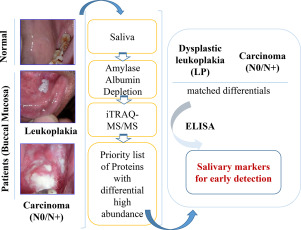当前位置:
X-MOL 学术
›
J. Proteomics
›
论文详情
Our official English website, www.x-mol.net, welcomes your
feedback! (Note: you will need to create a separate account there.)
Salivary proteins from dysplastic leukoplakia and oral squamous cell carcinoma and their potential for early detection.
Journal of Proteomics ( IF 2.8 ) Pub Date : 2019-11-07 , DOI: 10.1016/j.jprot.2019.103574 Priya Sivadasan 1 , Manoj Kumar Gupta 2 , Gajanan Sathe 3 , H V Sudheendra 4 , Sumsum P Sunny 5 , Durairaj Renu 6 , P S Hari 4 , H Gowda 2 , Amritha Suresh 5 , Moni Abraham Kuriakose 5 , Ravi Sirdeshmukh 7
Journal of Proteomics ( IF 2.8 ) Pub Date : 2019-11-07 , DOI: 10.1016/j.jprot.2019.103574 Priya Sivadasan 1 , Manoj Kumar Gupta 2 , Gajanan Sathe 3 , H V Sudheendra 4 , Sumsum P Sunny 5 , Durairaj Renu 6 , P S Hari 4 , H Gowda 2 , Amritha Suresh 5 , Moni Abraham Kuriakose 5 , Ravi Sirdeshmukh 7
Affiliation

|
Dysplastic leukoplakia (LP) of the oral cavity is a potentially malignant condition for oral squamous cell carcinoma (OSCC), early detection of which remains an unmet clinical need. In an effort to develop non-invasive biomarker based method for early detection of the disease, differential proteomic profiling was carried out with the saliva from patients with risk habits and diagnosed with LP and those with lymph node negative and positive OSCC in comparison to healthy controls with risk habits. Ninety three proteins were observed at elevated level (≥1.5 fold), and 30 were prioritized based on a scoring system comprising of confidence of identification, presence in the various specimen groups, functional relevance, and their secretory potential. Verification was carried out in independent patient cohorts for 8 selected, representative, upregulated proteins using ELISA. Three of them CD44, S100A7, and S100P were significantly altered in patients with LP as well as OSCC and can be regarded as a panel of biomarker candidates for early detection of the malignancy. Other members may also be investigated in a targeted manner to expand the portfolio of biomarkers for early detection. The mass spectrometry data are available via ProteomeXchange with identifier PXD015722. SIGNIFICANCE: There is an unmet clinical need for non-invasive, biomarker based methods for the improved early detection and the subsequent management of oral cancer. The study represents differential proteome profiling of the saliva of patients with oral dysplastic leukoplakia (LP) - a potentially malignant lesion, patients diagnosed with oral squamous cell carcinoma (OSCC), and healthy controls to identify potential markers for the purpose of early detection of malignancy. From among the matched and prioritized proteins with elevated levels in the saliva of patients with LP and those with OSCC, eight were verified. Three of them - CD44, S100A7 and S100P appeared promising candidates as biomarkers for early detection of the neoplastic predisposition and may form the basis of clinical assays for this purpose.
中文翻译:

增生异常性白斑和口腔鳞状细胞癌的唾液蛋白及其早期发现的潜力。
口腔发育不良性白斑(LP)是口腔鳞状细胞癌(OSCC)的潜在恶性疾病,其早期检测仍未满足临床需求。为了开发一种基于无创生物标志物的疾病早期检测方法,与健康对照组相比,对具有危险习惯和诊断为LP以及淋巴结阴性和阳性OSCC的患者的唾液进行了差异蛋白质组分析有风险习惯。在升高的水平(≥1.5倍)处观察到了九十三种蛋白质,并基于一个评分系统对30种蛋白质进行了优先排序,该评分系统包括鉴定的信度,各个样本组中的存在,功能相关性及其分泌潜能。在独立的患者队列中对8个代表性代表进行了验证,使用ELISA上调蛋白质。其中三个CD44,S100A7和S100P在LP和OSCC患者中发生了显着改变,可以被认为是早期发现恶性肿瘤的生物标志物候选物。还可以有针对性地对其他成员进行调查,以扩大生物标记物的组合,以进行早期检测。质谱数据可通过ProteomeXchange获得,其标识符为PXD015722。意义:对于基于无创生物标志物的方法,用于改善口腔癌的早期检测和后续管理的临床需求尚未得到满足。这项研究代表了口腔发育不良白斑(LP)(一种潜在的恶性病变),诊断为口腔鳞状细胞癌(OSCC),和健康的对照,以识别潜在的标志物,以便及早发现恶性肿瘤。从LP和OSCC患者唾液中水平升高的匹配和优先蛋白质中,验证了八种。其中的三个-CD44,S100A7和S100P有望成为早期发现肿瘤易感性的生物标志物,并可能构成为此目的进行临床检测的基础。
更新日期:2019-11-08
中文翻译:

增生异常性白斑和口腔鳞状细胞癌的唾液蛋白及其早期发现的潜力。
口腔发育不良性白斑(LP)是口腔鳞状细胞癌(OSCC)的潜在恶性疾病,其早期检测仍未满足临床需求。为了开发一种基于无创生物标志物的疾病早期检测方法,与健康对照组相比,对具有危险习惯和诊断为LP以及淋巴结阴性和阳性OSCC的患者的唾液进行了差异蛋白质组分析有风险习惯。在升高的水平(≥1.5倍)处观察到了九十三种蛋白质,并基于一个评分系统对30种蛋白质进行了优先排序,该评分系统包括鉴定的信度,各个样本组中的存在,功能相关性及其分泌潜能。在独立的患者队列中对8个代表性代表进行了验证,使用ELISA上调蛋白质。其中三个CD44,S100A7和S100P在LP和OSCC患者中发生了显着改变,可以被认为是早期发现恶性肿瘤的生物标志物候选物。还可以有针对性地对其他成员进行调查,以扩大生物标记物的组合,以进行早期检测。质谱数据可通过ProteomeXchange获得,其标识符为PXD015722。意义:对于基于无创生物标志物的方法,用于改善口腔癌的早期检测和后续管理的临床需求尚未得到满足。这项研究代表了口腔发育不良白斑(LP)(一种潜在的恶性病变),诊断为口腔鳞状细胞癌(OSCC),和健康的对照,以识别潜在的标志物,以便及早发现恶性肿瘤。从LP和OSCC患者唾液中水平升高的匹配和优先蛋白质中,验证了八种。其中的三个-CD44,S100A7和S100P有望成为早期发现肿瘤易感性的生物标志物,并可能构成为此目的进行临床检测的基础。











































 京公网安备 11010802027423号
京公网安备 11010802027423号